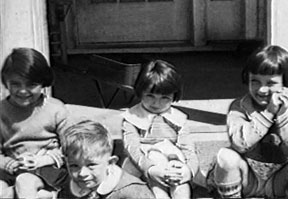Announcing the publication of Jackie Jackson's life work:
“Jackie Jackson throws open the Round Barn doors at the Dougan family farm to tell us an American story. She gives us a rich history of farm life at the mercy of the forces of science and the market but grounded in rock-solid Wisconsin values.” Dick Durbin, U.S. Senator
Cinematic Advertisement
This film was created as an advertisement to be shown in the local theatre prior to the feature.

Jo, Craig, Jackie, and Patsy
—from Chapter 7: MOVIE, 1932
It’s early April of 1932; Patsy is five. She and her sisters and brother are on the screened-in porch of the Big House, keeping clean. They are waiting for the photographer. This isn’t an ordinary photographer, the sort that takes their picture every Christmas for the Christmas card. That one sets up a camera on a tall three legged stand. His camera has a black accordian pleated front which he stretches way out, and then he gets under a black cloth and fusses and fusses, and finally holds his arm up. There is a little heap of powder on a tray, and when he snaps the picture the powder flashes and smokes and smells, and you have spots in your eyes for a while. It takes a great deal of patience and staying still to have that sort of picture taken.
It takes patience for this sort, too. But this is different. They will get to move, for this is a movie. It’s going to be shown in the movie theaters downtown, for advertising. Mother has rehearsed them on their part. They will come out of the porch and walk down the sidewalk, first herself, Patsy, pushing the toy wheelbarrow, then Joan, then Jackie with the wicker doll buggy, and last of all Craig, on his tricycle. Meanwhile she is infinitely bored. They are all infinitely bored.
Back in March, when Daddy and Mother and Grampa are planning the movie, sitting around the table in the Little House, Patsy listens in. So does Joan. Think of making a movie!
It cannot be a long one. People waiting for a film to begin don’t want to sit through long advertisements. But it should show the whole story of producing milk.
“So we must start with the land,” Grampa says. “The land is the foundation of everything, that fertile skin between bedrock and sky that makes our lives possible.”
Grampa and Daddy plot the tractors, the plows, the harrow, the disk, the drag, and also the fields where these will be filmed. “I will manage the horses,” says Grampa firmly.
Then the young stock will be shown, and the bulls, and next the cows and the milking in the round barn. Mother says cleanliness must be stressed, and Grampa and Daddy agree. From the milking the scene will shift to the milkhouse and the bottling and capping of the milk. Then comes a master stroke. Daddy leads everyone outside while he demonstrates.
“We’ll load full milk cases into this delivery truck,” he
says, slinging an empty case through the truck’s open back
doors. “And then the milk man will shut the doors — ”
Daddy shuts them,
“ — and the camera will fasten on the
words on the door, our slogan, ‘The Babies’ Milk Man.’
That will be a fitting end to the movie. Our milk on its
way to the consumer.” He points and writes and draws
for Grampa.
Grampa studies the page and the truck, back and forth. He opens and shuts the doors, looking at the motto. He nods and nods. Patsy studies the doors, too. She nods. “Except we have not yet finished the story,” Grampa says. “We’ve left out the consumer, the only reason for our milk production. We must have the cubbies.”
And that is why she and Joan and Craig and Jackie are waiting on the porch, in their sweaters and caps. They are to be the finale of the movie.
